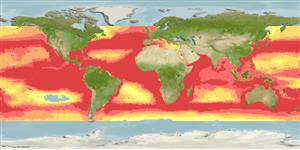Classification / Names
Common names from other countries
Main reference
Size / Weight / Age
Max length : 500 cm TL male/unsexed; (Ref. 35388); common length : 335 cm TL male/unsexed; (Ref. 13562); max. published weight: 400.0 kg (Ref. 9987)
Length at first maturity
Lm ?, range 265 - ? cm
Environment
Marine; brackish; pelagic-oceanic; oceanodromous (Ref. 13562); depth range 0 - 200 m (Ref. 5578), usually 0 - 20 m (Ref. 55303)
Climate / Range
Subtropical, preferred 26°C (Ref. 107945); 59°N - 55°S, 180°W - 180°E
Distribution
Widespread in temperate and tropical seas (Ref. 13562). Western Atlantic: Canada to the Virgin Islands; Brazil to Argentina. Eastern Atlantic: British Isles to Côte d'Ivoire, including the Mediterranean. Indo-Pacific: South Africa to Sri Lanka; southern Siberia to Viet Nam (Ref. 13562); southern Australia, New Zealand, and Hawaii (Ref. 13562). Eastern Pacific: northern California, USA to Chile.
Countries | FAO areas | Ecosystems | Occurrences | Introductions
Short description
Dorsal
spines
(total): 0;
Dorsal
soft rays
(total): 0;
Anal
spines: 0;
Anal
soft rays: 0. A large hammerhead with a notch at the center of head; 1st dorsal fin moderately high, 2nd dorsal and pelvic fins low (Ref. 5578). Olive-grey or dark grey above, white below (Ref. 5578). Fins nearly plain, dusky or blackish tipped (Ref. 13562).
IUCN Red List Status (Ref. 115185)
Human uses
Fisheries: commercial; gamefish: yes
More information
ReferencesAquacultureAquaculture profileStrainsGeneticsAllele frequenciesHeritabilityDiseasesProcessingMass conversion
Tools
Special reports
Download XML
Internet sources
Estimates of some properties based on models
Phylogenetic diversity index
PD50 = 0.5029 many relatives (e.g. carps) 0.5 - 2.0 few relatives (e.g. lungfishes)
Trophic Level
4.9 ±0.5 se; Based on diet studies.
Resilience
Low, minimum population doubling time 4.5 - 14 years (Fec=20-50)
Vulnerability
Very high vulnerability (85 of 100)
Price category
